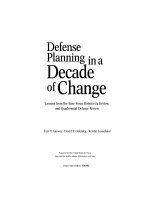Leading Change pot
Bạn đang xem bản rút gọn của tài liệu. Xem và tải ngay bản đầy đủ của tài liệu tại đây (552.01 KB, 55 trang )
NGHỆ THUẬT LÃNH ĐẠO
MSMH: NS301DV01
Chapter 5:
Leading Change
Purpose
After studying this chapter, you will be able to:
•
Define change and explain the forces for change
•
Describe types of change and explain the change
process
•
Summarize the reasons for resistance to change
and possible solutions
•
Present the leadership practices necessary to
implement change, including the importance of
vision
•
Highlight the organization characteristics that
support change
Content
Forces for change
Types and process of change
Resistance to change and solutions
Leading change
Creativity and improvisation
Changing how organizations approach
change
Chapter 5
5.1- Forces for
Change
Change and Innovation
•
Change is the transformation or adaptation to a
new way of doing things.
•
Innovation is the use of resources and skills to
create an idea, product, process, or service that
is new to the organization or its shareholders.
Targets of Change
Forces for Change
Forces for change are both external (in the
environment) and internal.
–
Changes in the environment include factors such as
social trends, cultural and demographic changes,
political shifts, the economy, and technological
advances.
–
Force for change inside organizations is the
performance gap – the difference between expected
and actual performance, the new leadership at any
level.
Forces for Change
Chapter 5
5.2- Culture and
Change
Culture and Change
•
As pressure for change increases from inside and
outside of organizations, not all leaders react and
respond the same way.
–
Some perceive the pressure as a threat; others see it
as an opportunity.
•
One factor that determines the way leaders and
their followers perceive pressures for change is
culture, both at the national and organizational
levels.
Culture and Change
•
In cultures where people do not easily tolerate
uncertainty and ambiguity, pressure for change
is seen as a threat, and is either ignored or
carefully planned and managed.
•
In cultures where change is tolerated and
perceived as an opportunity,
–
leaders deal with change by making quick changes to
their organizations, and implementing short-term
strategies that address the immediate pressures
relatively more quickly than in other cultures.
Culture and Change
•
Leaders from present-oriented cultures, where
time is linear, are likely to react fairly quickly to
change and focus on short-term planning.
•
Leaders from past- and future-oriented
cultures are less likely to react quickly to
change, taking time to plan and to consider the
long-term impact of their actions.
Chapter 5
5.3- Types and
Process of Change
Types of Change
Types of Change Description
Planned Change that occurs when leaders or
followers make a conscious effort to change
in response to specific pressure or problem.
Unplanned Change that occurs randomly and suddenly
without the specific intention of addressing
a problem.
Evolutionary Gradual or incremental change.
Convergent Planned evolutionary change that is the
result of specific and conscious actions by
leaders of followers to change the
organization.
Revolutionary or
frame-breaking
Change that is rapid and dramatic.
Model for Change
Kurt Lewin's Model of Change: a three-stage
process
•
Unfreezing:
•
Changing:
•
Refreezing:
Lewin's Model of Change
•
Unfreezing:
–
The existing practices and behaviors are questioned,
and motivation to change develops.
–
Leaders help followers “unfreeze” and realize that
there is a need for change.
Lewin's Model of Change
•
Changing:
–
New practices and policies are implemented, and new
behaviors and skills are learned.
–
Leaders support followers, emphasize the importance
of the change, correct the course as needed…
Lewin's Model of Change
•
Refreezing:
–
The newly learned behaviors and freshly implemented
practices are encouraged and supported to become
part of the employees’ routine activities.
–
Leaders coach, provide training, and use appropriate
reward systems to help solidify the changes that have
been implemented.
Lewin's Model of Change
Lewin’s model of change has 4 key
characteristics that leaders must consider:
–
The importance of recognizing the need for change
and preparing and motivating followers to implement it.
–
The inevitable presence of the resistance to change.
–
The focus on people as the source for learning and
changing
–
The need to support new behaviors and allowing
them to take hold.
Process of Planned
Change
The process has 6 steps, each of which requires different
types of resources and leadership skills.
•
Step 1 – Recognition of need for change: mirrors the
unfreezing phase of Lewin's model. Leaders and followers
must become aware of the need for change, and
recognize its importance to organization’s effectiveness or
survival *performance gap, employee dissatisfaction,
external pressure from customers or competitors…
• Step 2 – Development of alternatives and ideas for
change: can be done by organizational leaders at
different levels, through small groups or teams, or even
with participation of outsiders.
Process of Planned
Change
•
Step 3 & 4 – Adoption of ideas, and implementation of
the change plan: mirrors Lewin’s change phase.
•
Step 5 – Allocation of resources: Leaders have either to
allocate new resources or shift current resources to help
implement change and “freeze” the change.
•
Step 6 – Evaluation of the change process and its
outcomes: The process of change is a continuous and
dynamic loop. After change is implemented, the
organization must review and evaluate its effectiveness,
and assess whether the objectives are met. If the goals
are not achieved, the change process starts over with the
recognition once again of the need to change.
Dealing with Unplanned
Change
•
Change is frequently sudden, unpredictable,
and not planned: the economy changes,
competitors come up with a new product, an
environmental disaster happens, or unions go on
strike…
•
Managing unplanned change falls into the domain
of crisis management. A crisis occurs when
leaders and their organizations substantially
misread their environment or are caught off guard
by events they could not have foreseen.
Dealing with Unplanned
Change
•
Leaders can manage unplanned change to some extent
by taking the following steps before a crisis develops:
– Avoid allowing the organization from becoming too
formal, hierarchical, rigid, and inflexible.
– Infuse moderate amount of unreliability,
unpredictability, and spontaneity into decisions to help
prevent complacency.
– Stay on the offensive and be proactive with introducing
new strategies, products, services, or processes.
–
Replace and rotate leaders to bring it new ideas,
methods, and visions.
– Experiment often with new methods, products,
processes, structures… to help followers practice
dealing with change.









